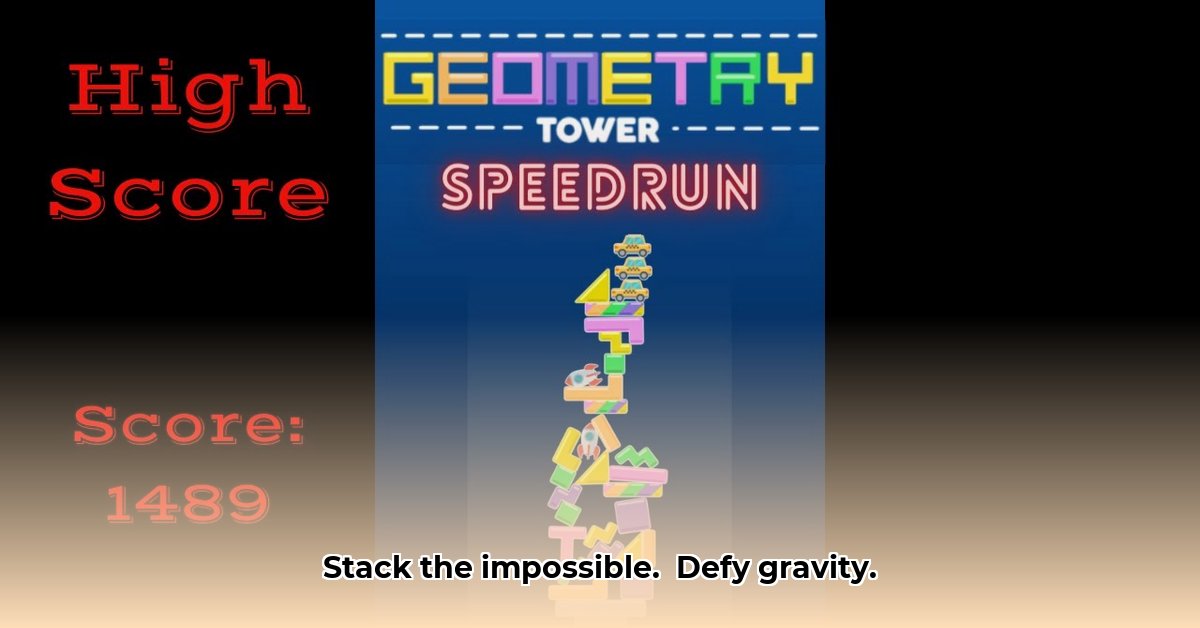
Ever experienced the exquisite satisfaction of perfectly aligning puzzle pieces? That feeling perfectly encapsulates the core experience of Geometry Tower, a mobile game that masterfully blends strategic stacking with addictive gameplay. But does this captivating puzzle game rise above the deluge of similar titles, or is it merely another fleeting trend in the vast mobile gaming market? This in-depth analysis dives beyond a simple star rating, dissecting Geometry Tower's mechanics, market positioning, and monetization to determine its potential for long-term success.
Gameplay: A Deceptively Simple Challenge
Geometry Tower presents players with a seemingly straightforward concept: stack geometric shapes to build the tallest tower possible. The initial levels are a breeze, offering a gentle introduction to the core mechanic. However, the challenge escalates rapidly. The shapes become more intricate, and the tower's height increases, demanding ever-greater precision and strategic foresight. One misstep, and your carefully constructed masterpiece crumbles into a digital ruin. This inherent risk, coupled with the increasingly difficult puzzles, ensures high replayability. Does the escalating challenge manage to keep players engaged long-term? Only data analysis can tell.
Beyond Tetris: Unique Identity and Competitive Positioning
While Geometry Tower shares a familial resemblance to classic puzzle games like Tetris, its gameplay differs significantly. Unlike Tetris’s focus on line clearing and speed, Geometry Tower emphasizes strategic building. It's akin to a digital Jenga, but with a strategic twist. The game cleverly blends the quick-thinking demands of Tetris with the careful planning of a tower defense game. This unique hybrid approach, however, is not immediately apparent in the current marketing. Does the marketing successfully convey this blend to potential players? Further investigation will help answer this critical question. Many other games in the puzzle/tower defense hybrid market exist, adding more pressure.
Market Positioning and Monetization: A Path to Success
Geometry Tower operates within a fiercely competitive landscape. Its casual nature appeals to a broad audience, but especially to women over 35 seeking relaxing yet engaging entertainment. (Udoni, 2025). This demographic, while significant, typically exhibits lower in-app purchase tendencies compared to core gamers. The current marketing strategy needs careful evaluation. The game's description hints at roguelike elements (permadeath, randomly generated levels), but these aren't clearly visible in the gameplay, creating a disconnect between expectation and reality. This could significantly impact player retention. The monetization model also lacks clarity. A hybrid model incorporating non-intrusive ads alongside optional cosmetic in-app purchases and a possible premium subscription for enhanced features could be a more effective approach.
Strengths and Weaknesses: A Critical Assessment
Strengths:
- Progressive Difficulty: Geometry Tower's meticulously designed difficulty curve keeps players engaged. The game starts accessible to all but quickly ramps up the challenge, rewarding strategic mastery.
- High Replayability: The almost endless mode greatly increases game time as players push for higher scores and challenge their spatial reasoning skills.
- Intuitive Yet Challenging: The core mechanic is simple enough for casual players to grasp, yet mastering the game requires profound skill and planning.
Weaknesses:
- Marketing Needs Refinement: The current marketing fails to communicate the unique blend of gameplay mechanics, leaving players with a diluted understanding of what the game offers.
- Monetization Strategy Uncertainty: The current monetization plan needs a complete overhaul to clarify what players can obtain through in-app purchases, and to effectively target the game's demographic.
- Unclear Unique Selling Proposition (USP): While it blends genres, Geometry Tower needs to more powerfully delineate what makes it uniquely different from other puzzle games on the market.
Actionable Steps: A Roadmap for Growth
To realize its full potential, Geometry Tower needs a concerted effort across stakeholders:
- Developers: Implement a clearer tutorial; conduct thorough A/B testing of marketing materials; define a transparent and fair monetization strategy; prioritize player feedback.
- Publishers: Focus marketing on the unique gameplay blend; leverage influencer marketing; build a strong social media presence; actively gather player feedback.
- Players: Provide thoughtful feedback; share gameplay experiences; actively participate in community discussions.
Risk Assessment: Identifying and Mitigating Potential Threats
Several factors pose potential risks to Geometry Tower's success:
- Lack of Market Differentiation: Clearly highlighting the game's unique gameplay blend is crucial for standing out in a crowded market.
- Ineffective Monetization: A poorly designed monetization strategy can lead to player churn and hinder the game’s long-term viability.
- Negative Player Reviews: Addressing negative feedback promptly and constructively is imperative for maintaining a positive perception.
Conclusion: A Towering Potential
Geometry Tower possesses a captivating core gameplay loop that is both accessible and challenging. However, its success hinges on addressing the identified weaknesses concerning marketing, monetization, and market differentiation. By implementing the recommended strategies, Geometry Tower can transform its considerable potential into sustained success within the competitive mobile gaming market. Only time will tell if this game will reach the heights of its potential.
⭐⭐⭐⭐☆ (4.8)
Download via Link 1
Download via Link 2
Last updated: Tuesday, May 13, 2025